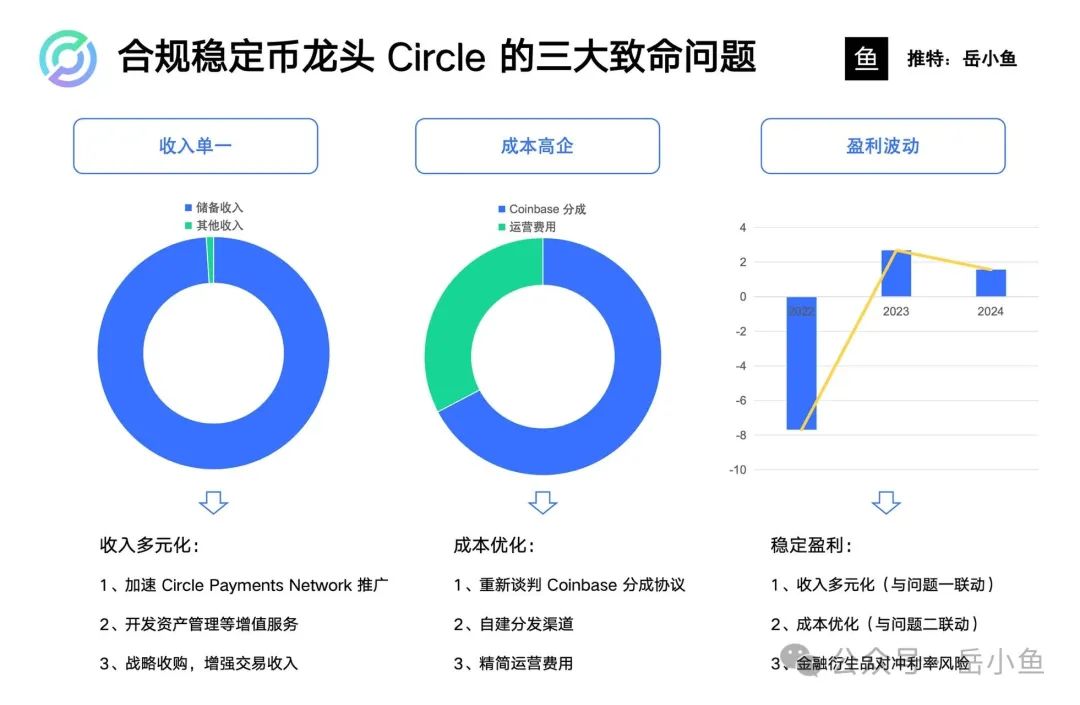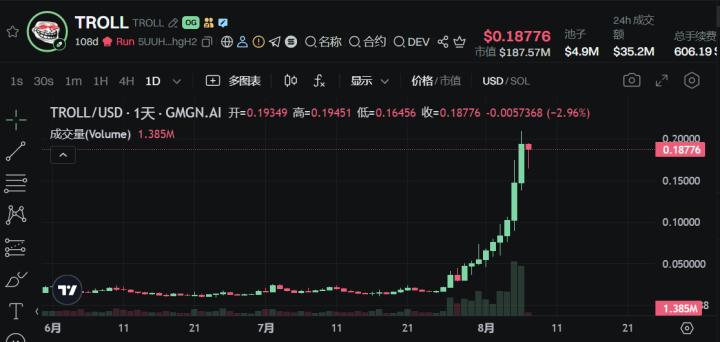Circle's listing has ignited market attention on stablecoins, with Circle becoming the first stock of compliant stablecoins, but behind its glamour lies potential crises.
After reviewing Circle's prospectus, three critical problems can be discovered:
First, single revenue source, with 99% coming from reserve fund income and only 1% from other sources;
Second, high costs, with 60% of revenue going to Coinbase, resulting in a net profit margin of only 9%;
Third, profit volatility, with unstable earnings - a net loss of $770 million in 2022, a profit of $270 million in 2023, and a decline to $160 million in 2024.
Let's examine the causes behind these three problems and the efforts Circle is making to address them.

1. Single Revenue Source
With 99% of income from reserve funds, Circle lacks other profit points, which is a clear "valuation ceiling" for a company.
Circle issues USDC, a stablecoin pegged 1:1 to the US dollar, backed by low-risk assets like US dollars and short-term government bonds.
When users hold USDC, Circle invests these funds in assets like US Treasury bonds, earning interest income while USDC holders do not receive interest.
This model is essentially "interest-free financing", where Circle invests user funds without incurring costs, similar to banks' deposit-lending model but with lower risk.
Circle's business model can be seen as a digital dollar bond arbitrage.
Circle's profitability depends on two variables:
First, USDC circulation - larger circulation means larger reserve asset scale and higher interest income;
Second, interest rate environment - US Treasury bond yields directly determine reserve income, with high-interest environments being extremely favorable for Circle.
Although Circle has established itself as a "compliant stablecoin leader" that can grow with the track, the Federal Reserve has entered a rate-cutting cycle, potentially reducing Treasury bond yields to 2% or lower, which would halve Circle's profits.
Moreover, as traditional finance enters the market and competitors begin paying interest to holders, Circle's "interest-free financing" model will face challenges and potentially lose market share in compliant stablecoins.
With only reserve fund income as a profit point, Circle cannot support a higher market value.
Circle's solutions include:
Accelerating Circle Payments Network promotion: Launching in May 2025 to provide instant, low-cost cross-border payment services using USDC, connecting banks, digital wallets, and payment service providers.
Developing value-added services: Creating USDC custody and asset management tools for institutional clients like crypto funds and banks, charging management fees.
Exploring non-USD stablecoins and emerging markets: Issuing EURC (Euro-pegged stablecoin) and planning to promote USDC and EURC in Asian and Latin American markets, which have shown effective growth.
2. High Costs
Circle gives 60% of its revenue to Coinbase, mainly as distribution and promotion fees.
This revenue-sharing ratio is a heavy burden for Circle.
The reason stems from USDC's development history, with Circle and Coinbase as joint founders.
Circle handles USDC issuance and reserve asset management, while Coinbase provides distribution channels, technical support, and market promotion, sharing USDC reserve income based on an agreement.
When USDC launched in 2018, Circle's brand and distribution capabilities were weak, relying on Coinbase's exchange status and user network to quickly expand USDC market share, thus Coinbase held a dominant position.
Coinbase, as the leading compliant US exchange, possesses strong bargaining power.
For a long time, USDC's circulation and trading volume heavily depended on Coinbase's infrastructure, making it difficult for Circle to separate quickly.
In 2024, based on a total circulation of $32 billion, Coinbase contributed approximately 50%-60% of USDC circulation, around $16-19.2 billion.
The Circle-Coinbase cooperation agreement includes an interesting clause: if Circle cannot distribute dividends or faces regulatory issues, Coinbase has the right to become the USDC issuer.
Although USDC is now fully issued and operated by Circle, Coinbase still plays a crucial role.
Circle recognizes the long-term risks of high revenue sharing and has taken measures like renegotiating sharing agreements and building independent distribution channels.
Renegotiating is challenging due to legal constraints, but building independent channels can effectively alleviate profit pressure from high revenue sharing.
3. Profit Volatility
Stablecoin market capitalization is strongly correlated with cryptocurrency market cycles.
Crypto market bull and bear cycles directly impact the overall stablecoin market scale.
Circle's net loss of $768.8 million in 2022 was due to the crypto bear market;
Its $267.6 million profit in 2023 resulted from cost control and rising interest rates;
The decline to $155.7 million in 2024 was caused by surging distribution costs.
USDC issuance has several key nodes:
First, the 2020 DeFi summer, with USDC issuance reaching $55 billion;
Second, the UST collapse in 2022, with massive funds flowing into USDC;
Third, Solana's strong rise in early 2023, providing good growth for USDC compared to USDT;
Fourth, the Silicon Valley Bank collapse in March 2023 and unfavorable SEC regulations, causing a 30-50% drop in USDC issuance;
Fifth, Trump's election win, triggering stablecoin growth to over $60 billion, an 80% increase.
Crypto market cycles and policy significantly impact stablecoin growth, especially for compliance-focused stablecoins like USDC.
To mitigate profit volatility, Circle needs to diversify income and optimize costs, leveraging its compliance advantages to consolidate market position.
In Summary
Stablecoins represent a transformation of the traditional financial system.
They are a crucial infrastructure replacing SWIFT, bank clearing and settlement, and foreign exchange systems.
Circle's vision extends beyond stablecoin issuance - they aim to build a new financial system with USDC as its core.
However, Circle faces numerous challenges, particularly the three critical problems mentioned.
Regardless of the outcome, Circle's listing has set a benchmark for the crypto industry, encouraging more attention to stablecoins, and we can continue to follow this financial system transformation.
Twitter: https://twitter.com/BitpushNewsCN
Bitpush Telegram Group: https://t.me/BitPushCommunity
Bitpush Telegram Subscription: https://t.me/bitpush







